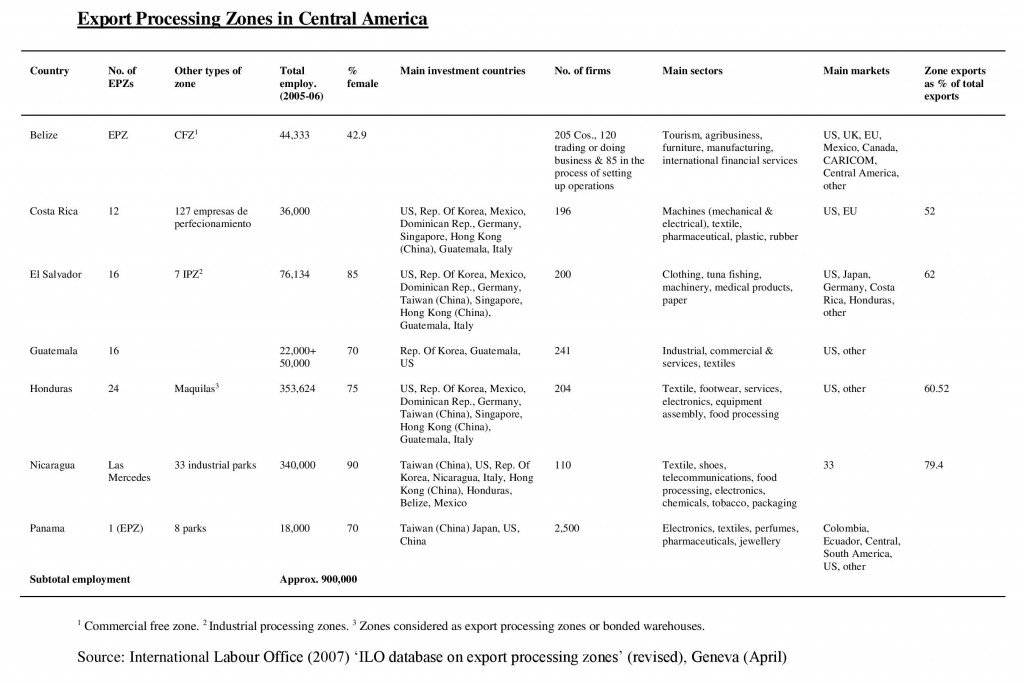Maquila refers to a system of production, or a factory, in which imported materials undergo a process of assembly or manufacturing, before being re-exported and sold abroad. In Central America maquilas are predominantly for the clothing industry, and are owned by companies from the US, Asia and Europe. They enjoy special tax and tariff regimes and provide cheap goods for markets in the north.
The maquila industry in Central America has been referred to as neoslavery,[1] and these ‘sweatshops’ are notorious for their poor working conditions. Organisations such as No Sweat, and War on Want have campaigned to bring awareness to this issue and forge a mental connection between the cheap garments available in high street stores and the abuse and violation of labour rights which goes on in the factories in which they were made.[2]
Maquila employees endure hazardous working conditions; lack of ventilation, excessive heat, dust, noise and lack of adequate safety equipment are frequent complaints. Bathroom breaks are monitored and timed. Shifts can range between ten and sixteen hours, and forced overtime, often unpaid, is also commonplace. 75% to 85% of maquila workers are women. They may be forced to take birth-control pills, take pregnancy tests, and pregnant women are routinely dismissed without notice or benefits. Workers may face verbal or sexual harassment. The staff turnover in maquilas is high; unemployment perpetuates the situation, as there are always more people desperate for work.[3]
Attempts to organise unions are often crushed, despite national and international labour rights legislation. Unionisation is difficult and minimal due a variety of factors including mass firing, intimidation, fear, death threats, unemployment and capital mobility.[4] When a worker is illegally fired for participating in union activities, they are commonly blacklisted, making it impossible to find similar job elsewhere.[5]
A report by the Maquila Solidarity Network suggests that that shrinking consumer markets due the global financial crisis will impede efforts to improve workplace conditions. They predict an increase in short-term and temporary contracting, less job security, factory closures, and greater anti-union pressure.[6]
[1] MacEoin. G., 13 August 1999 ‘Maquila neoslavery, under conditions from bad to inhuman – maquiladora industry in Central America’ National Catholic Reporter http://findarticles.com/p/articles/mi_m1141/is_36_35/ai_55553270/ (accessed 13 August 2009)
[2] See http://www.nosweat.org.uk; http://www.waronwant.org/
[3] See Armbruster-Sandoval, R. (2005) Globalization and cross-border labor solidarity in the Americas: The anti-sweatshop movement and the struggle for social justice, Routledge, New York; also Washington Office on Latin America (2009) ‘DR-CAFTA and worker’s rights: Moving from paper to practice’ (May) http://www.wola.org/images/stories/Rights%20and%20Development/wola_dr_cafta_rpt%20final.pdf (accessed 17 August 2009)
[4] Op.cit. (Armbruster-Sandoval)
[5] Op.cit. (Washington Office on Latin America)
[6] Maquila Solidarity Network (2009) ‘How will the global financial crisis affect the garment industry and garment workers?’ (February) http://en.maquilasolidarity.org/sites/maquilasolidarity.org/files/2009-02-25%20MSN-FinancialCrisis-Feb09-ENG.pdf (accessed 14 August 2009)

